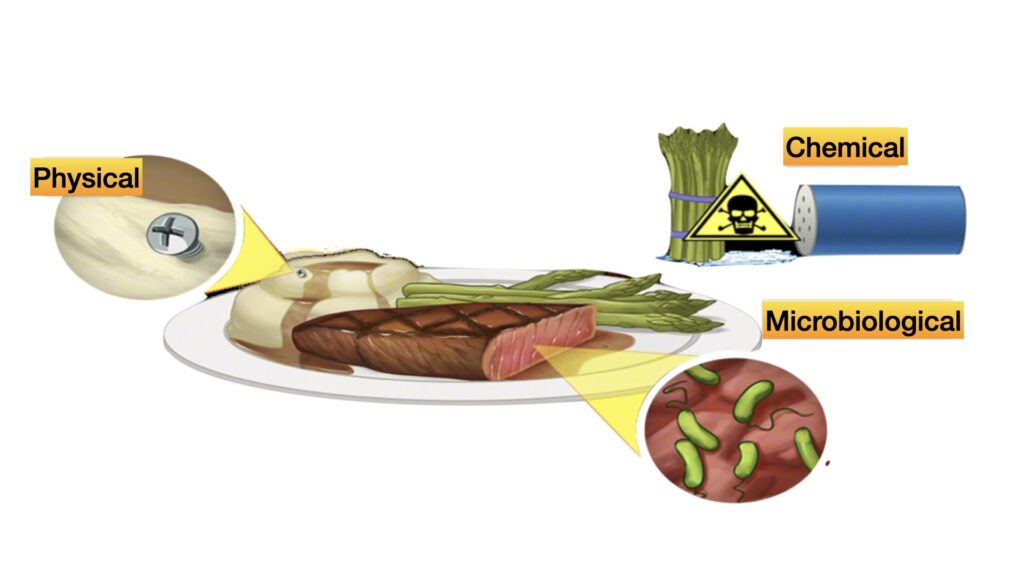1.4. Cross contamination 4:54
Cross-contamination of food
Cross-contamination is a process in which food is contaminated by bacteria and various harmful substances.
- Cross-contamination shall be divided into:
- Microbiological contamination means contamination in which bacteria, viruses and mould are released from raw materials, environmental objects or other sources of contamination or from raw materials on prepared foods. Microbiological cross-contamination is the most common cause of food poisoning.
- Chemical pollution, which releases chemicals (detergents, etc.) into food.
- Physical pollution, through which physical particles (glass, pebbles, etc.) enter the food.
- Allergic is a pollution that releases allergens into the food that can cause allergic reactions.
Examples of cross-contamination may include:
- Heatless (raw) food (meat, fish, vegetables, fruit). Such food may be contaminated with harmful bacteria and may be contaminated by direct contact with other food
- Pests (insects, pets, birds, rodents). They can carry harmful bacteria and contaminate food.
- Clean food handling environment. Food handled in such na environment can be contaminated with harmful bacteria or other sources of pollution.
- Food handlers. Individuals may be carriers of bacteria. Bacteria can be present in external parts of the body (arms, nose, mouth, hair) and inside the body (digestive tract).
- Heated food handled without personal hygiene requirements (e.g. without washing hands).
- Small food equipment (knives, cutting boards, choppers, etc.) used for cooking heat-treated and unprocessed food.
- A food handling site (surface) used for cooking heat-treated and unprocessed food;
- Wipes used to clean the surfaces of different (heat-treated and untreated) food treatments.
To avoid cross-contamination
- It is necessary to ensure that food handled directly does not come into contact with foodstuffs from previous stages of processing
- The quantity of inventory used for food management activities must be sufficient
- Different foods must be stored separately (on separate shelves or in separate enclosed containers).
- Food and raw materials and their routes of movement must be separated from prepared food
- Wash and drain thoroughly, hands, tools used, including cutting tables and knives, food handling surfaces, before processing fresh ̨ meat or other raw materials, before preparing meals and products to be consumed without heat treatment.
- For raw meat, poultry, fish, fruit and vegetables and ready-to-eat foods, different knives, cutting tables or other inventory must be used (e.g. different colour inventory may be used).
- Raw meat, poultry or fish must be stored at the bottom of the refrigerator and ready-to-eat food must be stored at the top of the refrigerator.
- Food prepared for consumption must be protected from other liquids (e.g. condensate, raw meat fluids, etc.).
- For food storage it is recommended to have separate refrigerators for uncooked and ready-to-eat food.
Food allergy
Allergy is na increased response of the immune system to external allergies. In addition to the food itself, allergic reactions can be caused by dietary dyes, preservatives, thickeners or seasoning added to it.
Allergens are substances that cause allergic reactions in the human body.
- It is not known exactly how many people have food allergies. However, even traces of allergen can cause allergic reactions in foods that are allergic, especially in children. In theory, any food can have allergens!
- The maximum allergen levels are determined in protein foods (milk, eggs, peanuts and other nuts, fish, crustaceans, soya and wheat, sesame seeds, lupins). All of this accounts for 90% of allergic food.
Food allergy. What is your duty?
- Most people who are allergic read the labels.
- Manufacturers must provide information on food allergens and all incoming ingredients.
- If the manufacturer is unsure about possible allergens, this should be warned on the packaging.
- Allergen-containing products and allergen-free products should be stored separately.
- To avoid cross-contamination by allergens, use different (labelled) inventory (vessels, tools) for different foods.



